Access Agilent eNewsletter, January 2014
>> Update My Profile | Subscribe to Access Agilent | Article Directory
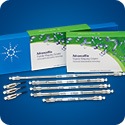
Achieving faster peptide mapping
By James Martosella and Alex Zhu
Agilent Bio-applications
Peptide mapping by reversed-phase chromatography is the mainstay technique in biotherapeutic analysis, delivering comprehensive characterization of biopharmaceutical products. When interfaced with a mass spectrometer, it can identify proteins and variants, determine post-translational modifications and locations, and confirm protein sequences.
However, peptide mapping represents a significant chromatographic challenge, due to the inherent complexity of protein digests. As a result, many laboratories struggle with developing robust and reliable peptide maps. In general, peptide maps have suffered from low sensitivity, poor peak shapes, and very long separation times to achieve the desired resolution.
The new 2.7 µm AdvanceBio Peptide Mapping column from Agilent fills a critical gap in biotherapeutics characterization, generating peptide maps that are both highly efficient and rapidly achieved, at low LC-system pressures. Using superficially porous chromatographic media, the Agilent AdvanceBio Peptide Mapping columns achieve substantial improvements in peptide mapping run times, while still maintaining high-efficiency peak performance.
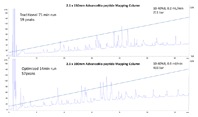 Enlarge
Enlarge
Figure 1. Fast HPLC optimizations of mAb tryptic digest. Top graph: 75 min separation on a 2.1 x 150 mm AdvanceBio Peptide Mapping column generating 59 peptide peaks. Bottom graph: optimized 14 min separation on a 2.1 x 100 mm AdvanceBio Peptide Mapping column generating 57 peptide fragment peaks.
Shortening run times without sacrificing results
To highlight improved performance, an AdvanceBio Peptide Mapping column was used for the rapid LC/MS analysis of a monoclonal antibody (mAb) tryptic digest. Traditionally, shallow gradients of 2 h or longer are employed for mapping mAb peptides, to achieve the desired baseline performance. The longer run times ensure that optimum resolution is achieved and that critical PTM peak information is not sacrificed during the shorter run. However, the Agilent AdvanceBio Peptide Mapping column has the flexibility to increase analysis speed without sacrificing separation performance. The LC/UV separations in Figure 1 demonstrate this flexibility. The top chromatogram shows a common peptide map generated over 75 min on a 2.1 x 150 mm column at a standard flow rate (relative to column id) of 0.2 mL/min. The separation provides excellent baseline resolution with 59 mAb tryptic digest peaks resolved over the entire gradient profile. The bottom chromatogram shows a 2.1 x 100 mm AdvanceBio column used with a very steep gradient at a high flow rate of 0.6 mL/min, but only at a fraction of the runtime (under 14 minutes). In this separation the mAb tryptic peak count remained relatively unchanged at 57 peaks, while baseline resolution, peak shapes, sensitivity, and selectivity were not compromised. Additionally, the column backpressure remained well under 500 bar, making this rapid and highly efficient separation achievable on traditional High-Performance Liquid Chromatography (HPLC) instrumentation.
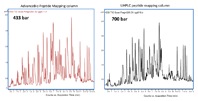 Enlarge
Enlarge
Figure 2. Total ion chromatograms for a mAb tryptic digest from an Agilent AdvanceBio Peptide Mapping column (red trace) and UHPLC peptide mapping column (black trace).
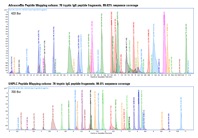 Enlarge
Enlarge
Figure 3. Extracted compound chromatograms of 76 tryptic IgG peptide fragments. Top: Agilent AdvanceBio Peptide Mapping column, 433 bar, yielding 99.63% sequence coverage. Bottom: non-Agilent UHPLC peptide mapping column, 700 bar, yielding 99.0% sequence coverage.
Attaining UHPLC performance at HPLC pressure
Peptide mapping by Ultra-High-Performance Liquid Chromatography (UHPLC) can provide more detailed characterization for protein biotherapeutics, by taking advantage of smaller particles packed in a shorter column length to achieve high efficiency mapping during faster run times. However, the pressure requirement for this type of separation becomes increasingly high, preventing operation on traditional 400 and 600 bar HPLC instruments and severely limiting its broader application. The 2.7 µm AdvanceBio Peptide Mapping column can generate UHPLC-like mapping performance while providing flexibility for use with UHPLC or HPLC instrumentation.
Figure 2 shows the reversed-phase LC/MS separation performance between an Agilent AdvanceBio Peptide Mapping column and a non-Agilent UHPLC peptide mapping column. The total ion chromatogram comparisons clearly detail very comparable resolving performance and indicate the AdvanceBio peptide column’s ability to resolve a mAb tryptic digest adequately and efficiently. Performance was comparable to the UHPLC/MS separation, but at a pressure of only 433 bar, traditional for HPLC.
In the comparison of extracted compound chromatograms shown in Figure 3, the AdvanceBio Peptide Mapping HPLC/MS analysis delivered excellent sequence coverage performance in comparison to the UHPLC/MS column analysis. Sequence coverage for the Agilent AdvanceBio column was 99.63%, while the UHPLC column delivered 99.0%. The flexibility to obtain UHPLC-like results on the AdvanceBio peptide mapping column, without the pressure requirements of UHPLC, can make this column a more attractive and universal choice for rapid and efficient characterization of biotherapeutics.
More peptide mapping options
Agilent offers a complete family of columns and instruments to improve peptide mapping. Download a free copy of Better Characterization of Biomolecules Using Agilent AdvanceBio Reversed-Phase Columns to learn how Agilent AdvanceBio Peptide Mapping columns and Agilent 1290 Infinity Bio-inert Quaternary LC can help you navigate your way to faster, better peptide maps.
>> Update My Profile | Subscribe to Access Agilent | Article Directory
Figure 1.
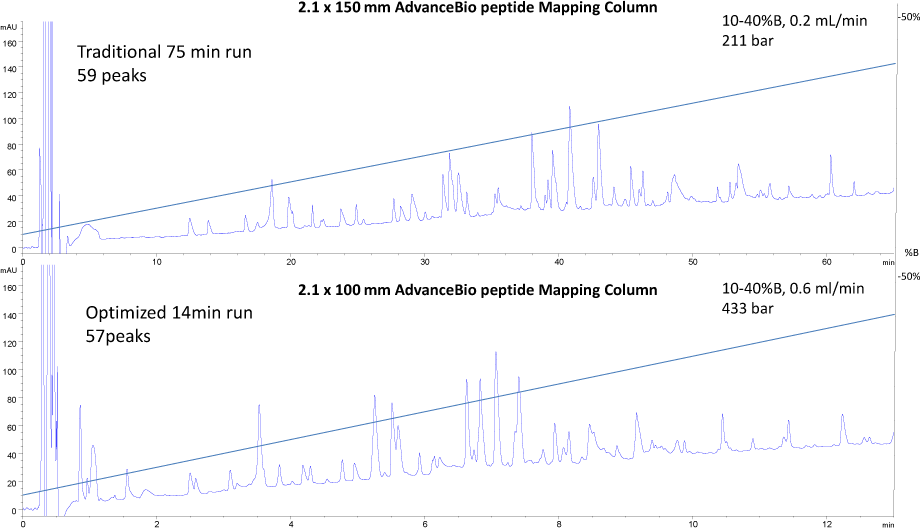
Conditions |
|
|---|---|
Mobile phase A |
water + 0.1% FA |
Mobile phase B |
90% ACN + 0.1% FA |
Injection |
15 µL |
Temperature |
40 °C |
DAD |
215 nm |
Fast HPLC optimizations of mAb tryptic digest. Top graph: 75 min separation on a 2.1 x 150 mm AdvanceBio Peptide Mapping column generating 59 peptide peaks. Bottom graph: optimized 14 min separation on a 2.1 x 100 mm AdvanceBio Peptide Mapping column generating 57 peptide fragment peaks.
Figure 2.
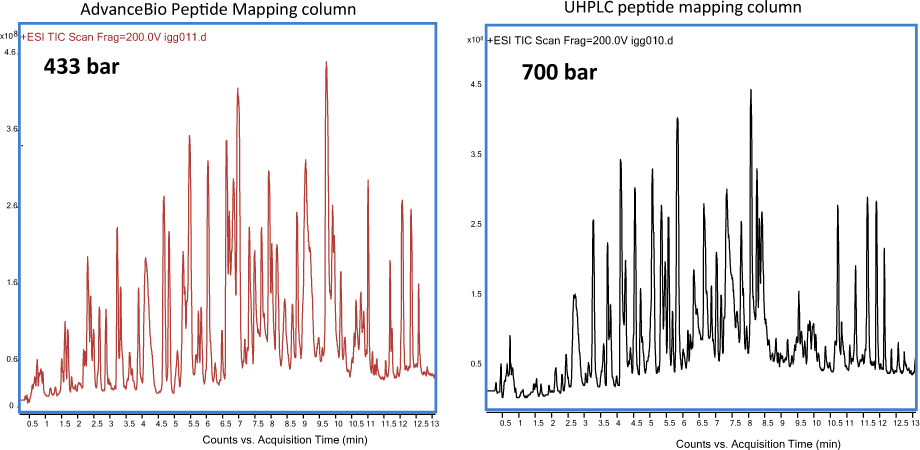
Conditions |
|||||||||||
|---|---|---|---|---|---|---|---|---|---|---|---|
Mobile phase A |
water + 0.1% FA |
||||||||||
Mobile phase B |
90% ACN + 0.1% FA |
||||||||||
Injection |
15 µL |
||||||||||
Flow |
0.6 mL/min |
||||||||||
Temperature |
40 °C |
||||||||||
Gradient |
|
||||||||||
Total ion chromatograms for a mAb tryptic digest from an Agilent AdvanceBio Peptide Mapping column (red trace) and UHPLC peptide mapping column (black trace).
Figure 3.
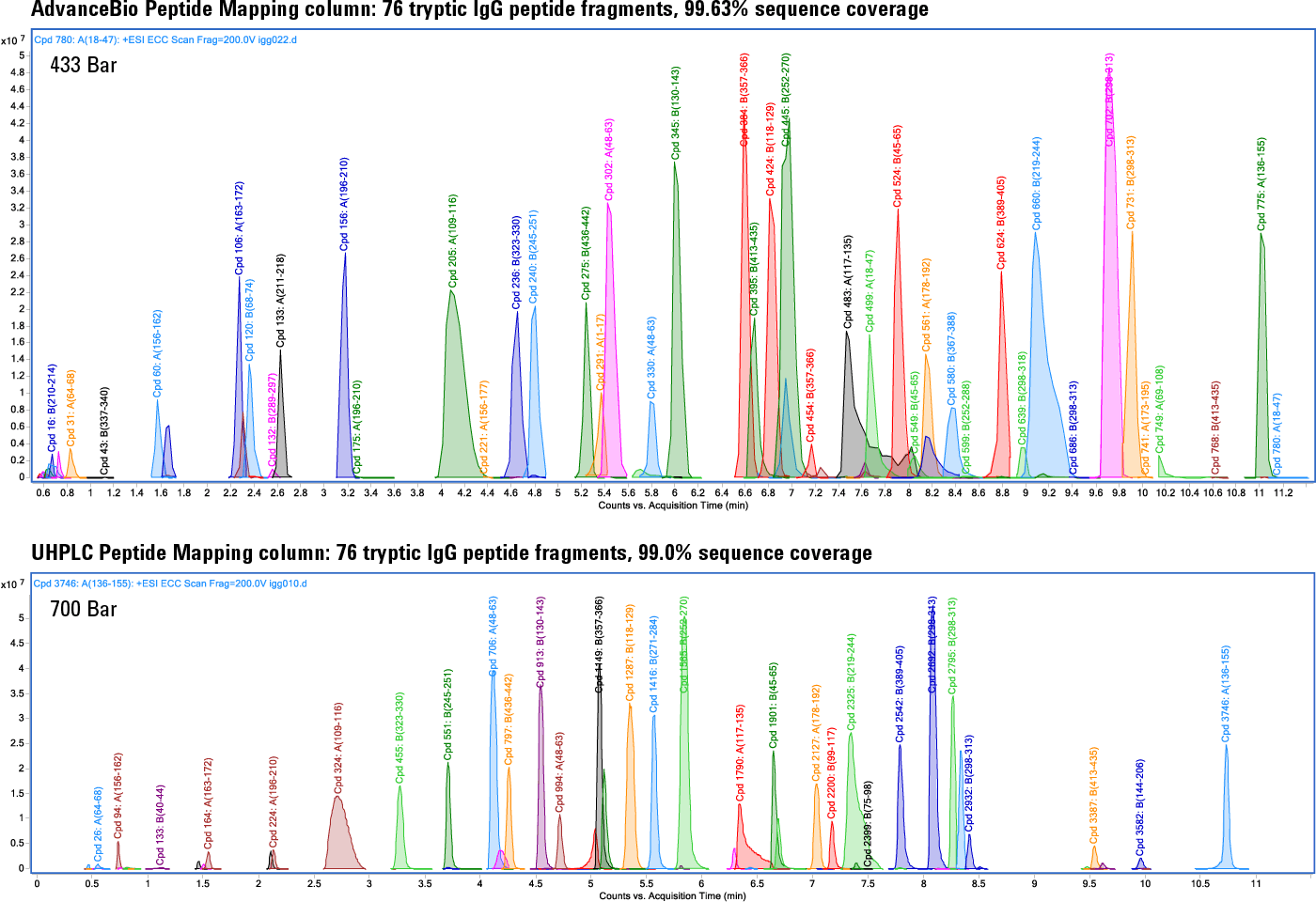
Conditions |
|||||||||||
|---|---|---|---|---|---|---|---|---|---|---|---|
Mobile phase A |
water + 0.1% FA |
||||||||||
Mobile phase B |
|||||||||||
Injection |
15 µL |
||||||||||
Flow |
0.6 mL/min |
||||||||||
Temperature |
40 °C |
||||||||||
Gradient |
|
||||||||||
Extracted compound chromatograms of 76 tryptic IgG peptide fragments. Top: Agilent AdvanceBio Peptide Mapping column, 433 bar, yielding 99.63% sequence coverage. Bottom: non-Agilent UHPLC peptide mapping column, 700 bar, yielding 99.0% sequence coverage.